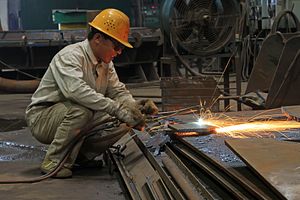On Wednesday, the U.S. Department of Commerce increased import duties on corrosion-resistant steel products (CORE) from China and a number of other countries in order to protect domestic steel producers.
The Department’s International Trade Commission carried out an investigation and concluded that China—in addition to India, Italy, Korea, and Taiwan—was “dumping” steel products on the U.S. market. Accusing China of selling the corrosion-resistant steel below market value, the Commission imposed an anti-dumping duty of 210 percent across Chinese CORE in addition to anti-subsidy duties as high as 241 percent.
In 2015, U.S. imports of CORE from China, India, Italy, Korea, and Taiwan were valued at an estimated $500.3 million, $219.6 million, $110 million, $509.1 million, and $534.4 million, respectively. The other countries faced duties ranging from over 3 percent to 92 percent.
In the report, the U.S. Commission singled out a number of Chinese companies for selling the corrosion-resistant steel products at less than their fair value. Yieh Phui Technomaterial Co., Ltd., which cooperated with investigators, was charged with a 39 percent countervailing subsidy.
However, businesses which didn’t comply with the Commission’s inquiry were slapped with massive import duties. Following the Department of Commerce’s final determination that the companies “failed to cooperate” in the investigation, Angang Group Hong Kong Company Ltd., Baoshan Iron & Steel Co., Ltd., Duferco S.A., Changshu Everbright Material Technology, and Handan Iron & Steel Group were imposed a countervailing subsidy of 241 percent.
China is the world’s largest manufacturer of steel, producing 50 percent of global output. The Department of Commerce says that the duties are an internationally accepted mechanism to seek relief from “injurious dumping and unfair subsidization of imports into the United States.”
Last week, the Commission imposed an anti-dumping rate of nearly 500 percent on cold-rolled steel from China, an input in home appliances and automobiles.
In regards to the May 20 ruling, an official from China’s Trade Remedy and Investigation Bureau expressed concern that “it breaks the WTO rules of free trade for the U.S. to so frequently restrict the steel products of other countries to enter the U.S. market.”
China has faced a steel glut since 2014. The nation has come under fire from the global steel industry for its tremendous overproduction, which has largely been pushed on overseas markets due to a poorly-performing domestic construction industry.
In April, China broke its own record for daily steel production with over 2.3 million tons. According to Bloomberg, China’s overseas sales in the first four months were already 7.6 percent higher at the same time in 2015, when the country exported a record 112 million tons.
The EU imposed tariffs on steel last year but many of its member countries’ steel manufacturers have suffered economically due to the falling world prices, which have corresponded with China’s exponential increases in production and exports.
Last week, the EU Parliament passed a non-binding resolution to prevent China from attaining market economy status in the WTO at the end of this year. Should China gain market economy status, it would effectively reduce the EU’s tools to combat cheap Chinese imports. In its official press release, the EU Parliament directly addressed the oversupply of steel from China as a threat to workers within its borders.
China’s steel output has increased by a factor of 12 in the last 25 years. By comparison, the EU’s production has decreased by 12 percent in that time span and the United States’ by 12 percent in the last year alone. In 2015 steel imports comprised 29 percent of the U.S. market and were responsible for roughly 12,000 layoffs in the industry.
Commenting on the global outlook, Hans Jürgen Kerkhoff, chairman of the World Steel Economics Committee said; “It is clear that the steel industry has, for the time being, reached the end of a major growth cycle which was based on the rapid economic development of China. Combined with China’s slowdown we also face low investment, financial market turbulence and geopolitical conflicts in many developing regions.”

































